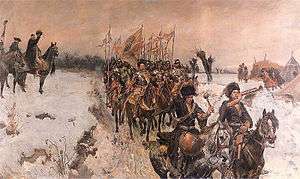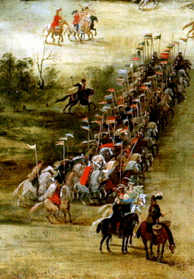Chorągiew
Chorągiew (Polish pronunciation: [xɔˈrɔŋɡʲɛf]; literally: "banner") was the basic administrative unit of the Polish cavalry from the 14th century. An alternative name until the 17th century was Rota.

Between the 14th and 17th century the Chorągiew was composed of smaller sub-units – the Poczet.
Types of Chorągiew were:
- Chorągiew ziemska (District banner), formed by knights of a district.
- Chorągiew rodowa (Clan banner), formed by clans.
- Chorągiew nadworna (Court banner), formed by troops of the King.
In the cavalry, since the second half of the 15th century until the first half of the 18th century, a Chorągiew was formed according to the "companion system" (system zaciągu towarzyskiego). See: Towarzysz (companion).

Types of Chorągiew were:
- Chorągiew husarska (Hussar banner), formed by Hussars.
- Chorągiew lekka ("Light" banner), formed by light-cavalry.
- Chorągiew pancerna ("Armoured" banner), formed by Pancerni.
- Chorągiew tatarska (Tatar banner), formed by Tatars.
- Chorągiew wołoska (Vlach banner), light cavalry, not only formed by Vlachs.
- Chorągiew kozacka (Cossack banner), light cavalry, not only formed by Cossacks.
Typical family/village clans of the Chorągiew Rodowa who provided men for battles consisting of approximately 100 men were:
Gallery
- District Banner of the Land of Grodno (1613–1619)
 A Hussar banner during the Battle of Kircholm in 1605
A Hussar banner during the Battle of Kircholm in 1605- A Hussar banner during the Battle of Kluszyn in 1610
gollark: So heavlisp is a significantly lispier heavlang?
gollark: No.
gollark: Do you type ☭ often enough that this ☭ is ☭ a ☭ problem?
gollark: I use LWIN, as a cool person.
gollark: Solution, though: give everyone 256-key keyboards to type bytes and make them do UTF-8 encoding in their head.
References
- PWN Leksykon: Wojsko, wojna, broń, Wydawnictwo Naukowe PWN, Warszawa 2001, ISBN 83-01-13506-9
- Winged Hussars, Radoslaw Sikora, Bartosz Musialowicz, BUM Magazine, October 2016.
This article is issued from Wikipedia. The text is licensed under Creative Commons - Attribution - Sharealike. Additional terms may apply for the media files.